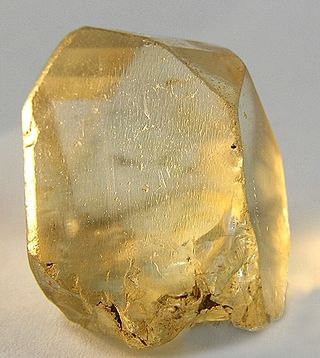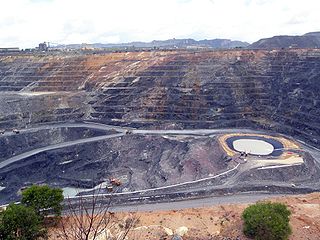
Uranium City is a northern settlement in Saskatchewan, Canada. Located on the northern shores of Lake Athabasca near the border of the Northwest Territories, it is 230 metres (750 ft) above sea level. The settlement is 760 kilometres (470 mi) northwest of Prince Albert, 760 kilometres (470 mi) northeast of Edmonton and 48 kilometres (30 mi) south of the Northwest Territories-Saskatchewan boundary. For census purposes, it is located within the province's Division No. 18 territory.

Cameco Corporation is the world's largest publicly traded uranium company, based in Saskatoon, Saskatchewan, Canada. In 2015, it was the world's second largest uranium producer, accounting for 18% of world production.

SM Investments Corporation (SMIC), also known as SM Group, is a Filipino conglomerate with interests in various sectors, mostly in shopping mall development and management, retail, real estate development, banking, and tourism. Founded by Henry Sy, it has become one of the largest conglomerates in the Philippines, being the country's dominant player in retail with 208 stores nationwide. Of these, 47 are SM Department Stores; 38 are SM Supermarkets; 37 are SM Hypermarkets, and 86 are SaveMore branches.

Fort de la Corne was one of the two French forts established on the Saskatchewan River in the 20 years between the end of La Vérendrye's push west from Lake Superior in 1731–1743 and the fall of New France in 1763.

The Department of Environment and Natural Resources, abbreviated as DENR, is the executive department of the Philippine government responsible for the conservation, management, development, and proper use of the country’s environment in natural resources, specifically forest and grazing lands, mineral resources, including those in reservation and watershed areas, and lands of the public domain, as well as the licensing and regulation of all natural resources as may be provided for by law in order to ensure equitable sharing of the benefits derived therefrom for the welfare of the present and future generations of Filipinos.
Japan Energy Corporation was a Japanese petroleum company, a wholly owned subsidiary of Nippon Mining Holdings. The petroleum products of Japan Energy Corporation were sold by filling stations under the brand name JOMO.
Rabbit Lake is the second largest uranium milling facility in the western world, and is the longest-operating uranium production facility in Saskatchewan. The facility is located approximately 800 km north of Saskatoon, Saskatchewan, on the northeast edge of the uranium rich Athabasca Basin. The closest community is Wollaston Lake, about 40 kilometers by lake or air. Rabbit Lake was the first Canadian mine to offer a seven-days-in/seven-days-out commuter system of staffing. Access is provided by Highway 905. Production at Rabbit Lake was suspended in April 2016.

Denison Mines Corp. is a Canadian uranium exploration, development, and production company. Founded by Stephen B. Roman, and best known for its uranium mining in Blind River and Elliot Lake, it later diversified into coal, potash, and other projects.

The Mining industry of Ghana accounts for 5% of the country's GDP and minerals make up 37% of total exports. Gold contributes over 90% of the total mineral exports. Thus, the main focus of Ghana's mining and minerals development industry remains focused on gold. Ghana is Africa's largest gold producer, producing 80.5 t in 2008. Ghana is also a major producer of bauxite, manganese and diamonds. Ghana has 20 large-scale mining companies producing gold, diamonds, bauxite and manganese; over 300 registered small scale mining groups; and 90 mine support service companies. Other mineral commodities produced in the country are natural gas, petroleum, salt, and silver.

The mining of minerals in Nigeria accounts for only 0.3% of its gross domestic product, due to the influence of its vast oil resources. The domestic mining industry is underdeveloped, leading to Nigeria having to import minerals that it could produce domestically, such as salt or iron ore. The rights to ownership of mineral resources is held by the Federal Government of Nigeria, which grants titles to organizations to explore, mine, and sell mineral resources. Organized mining began in 1903, when the Mineral Survey of the Northern Protectorates was created by the British colonial government. A year later, the Mineral Survey of the Southern Protectorates was founded. By the 1940s, Nigeria was a major producer of tin, columbite, and coal. The discovery of oil in 1956 hurt the mineral extraction industries, as government and industry both began to focus on this new resource. The Nigerian Civil War in the late 1960s led many expatriate mining experts to leave the country. Mining regulation is handled by the Ministry of Solid Minerals Development, who are tasked with the responsibility of overseeing the management of all mineral resources in Nigeria. Mining law is codified in the Federal Minerals and Mining Act of 1999. Historically, Nigeria's mining industry was monopolized by state-owned public corporations. This led to a decline in productivity in almost all mineral industries. The Obasanjo administration began a process of selling off government-owned corporations to private investors in 1999. The Nigerian Mining Industry has picked up since the "Economic Diversification Agenda", from Oil & Gas, to Agriculture, Mining, etc., began in the country.

Mining is the biggest contributor to Namibia's economy in terms of revenue. It accounts for 25% of the country's income. Its contribution to the gross domestic product is also very important and makes it one of the largest economic sectors of the country. Namibia produces diamonds, uranium, copper, magnesium, zinc, silver, gold, lead, semi-precious stones and industrial minerals. The majority of revenue comes from diamond mining. In 2014, Namibia was the fourth-largest exporter of non-fuel minerals in Africa.

Radioactive ores were first extracted in South Australia at Radium Hill in 1906 and Mount Painter in 1911. 2,000 tons of ore were treated to recover radium for medical use. Several hundred kilograms of uranium were also produced for use in ceramic glazes.

Canada is the world's second-largest producer of uranium, behind Kazakhstan. In 2009, 20% of the world's primary uranium production came from mines in Canada. 14.5% of the world production came from one mine, McArthur River. Currently, the only producing area in Canada is northern Saskatchewan, although other areas have had active mines in the past.
Geo-Mineral Exploration Corporation is an environmentally-sensitive exploration, acquisition, and merger company, which examines the viability of consolidating historic underground mining properties into small-scale specialty production alliances. The Geo-Mineral Corporation and its independent affiliates, are fully American-owned and operated.
SMDC refers to the United States Army Space and Missile Defense Command.

ENEOS Holdings, Inc. (ENEOSホールディングス株式会社) is a Japanese global petroleum and metals conglomerate headquartered in Tokyo, Japan. In 2012 the multinational corporation consisted of 24,691 employees worldwide and, as of March 2013, JX Holdings was the forty-third largest company in the world by revenue. It is one of the core companies of the Mitsubishi Group through its predecessor 's merger with Mitsubishi Oil.
The PSE Mining and Oil Index is the sub-index of the Philippine Stock Exchange for mining and oil companies. It is one of the six sub-indices of the PSE that provide a useful measurement of sectoral performance.

The Central Mine Planning and Design Institute is a subsidiary of Coal India Limited which is under the ownership of the Ministry of Coal, Government of India, engaged in the field of environmental engineering and provides consultancy and engineering services across the globe. It is a public sector undertaking under the Government of India and is rated as a Schedule-B and Mini Ratna-II company.

Birch Narrows Dene Nation is a Dene First Nation band government in the boreal forest region of northern Saskatchewan, Canada. It is affiliated with the Meadow Lake Tribal Council (MLTC).












